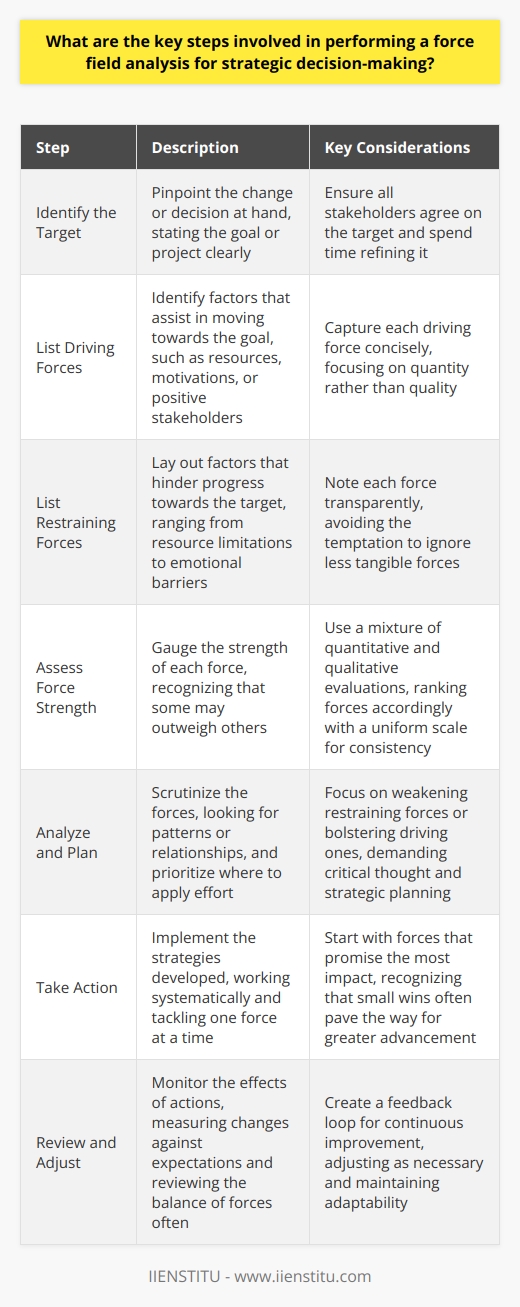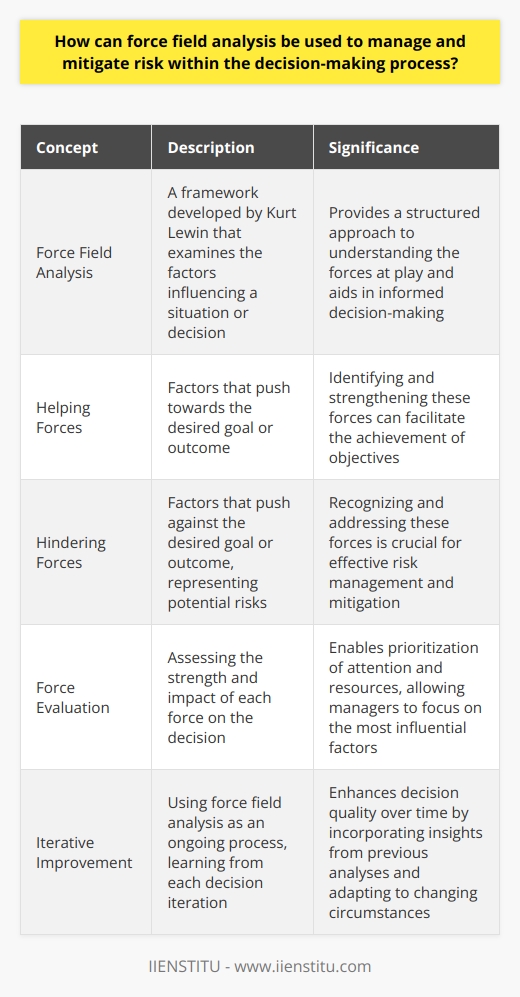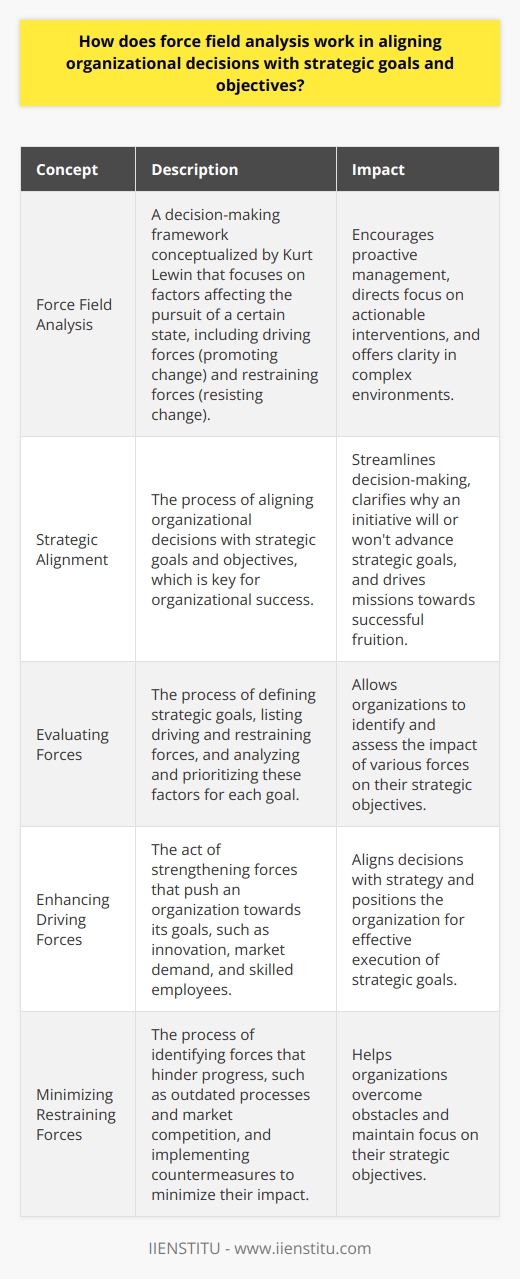
Have you ever faced a problem that seemed insurmountable, with obstacles popping up at every turn? I certainly have. There was a time when I felt overwhelmed by a complex project at work, unsure of how to navigate the myriad challenges ahead. That's when I stumbled upon Force Field Analysis, a tool that not only helped me dissect the problem but also paved the way for effective solutions. In this post, I'll share my experiences with this invaluable method and how it can revolutionize your approach to problem-solving.
Understanding Force Field Analysis
The Birth of a Problem-Solving Tool
My introduction to Force Field Analysis happened during a particularly tough phase in my career. I was leading a team on a project that was falling behind schedule. Deadlines loomed, and the pressure was mounting. Desperate for a solution, I recalled a concept I had briefly encountered in a management course: Force Field Analysis, developed by social psychologist Kurt Lewin in the 1940s.
Lewin designed this analytical tool to understand the factors influencing a situation, especially in group dynamics and organizational change. But what intrigued me was its applicability in everyday problem-solving. It offered a structured way to visualize the driving forces propelling us toward our goals and the restraining forces holding us back.
Breaking Down the Components
At its core, Force Field Analysis is about balance. On one side, you have driving forces—the positive factors that support your goal. On the other, restraining forces—the negative factors that hinder progress. By mapping these out, you can strategize on enhancing the positives and mitigating the negatives.
I decided to apply this to my project. I gathered my team, and we listed all the factors helping us meet our deadline (like team expertise and resource availability) and those impeding us (such as unclear client requirements and technical challenges). Seeing everything laid out was a game-changer.
Why Force Field Analysis Enhances Problem-Solving
Clarity Amidst Complexity
One of the biggest hurdles in problem-solving is the overwhelming complexity of issues. Force Field Analysis breaks down problems into manageable parts. For me, it transformed a chaotic situation into a clear visual diagram, highlighting exactly where we needed to focus our efforts.
Universal Applicability
What makes this tool remarkable is its versatility. Whether you're dealing with personal dilemmas, like deciding to relocate for a new job, or professional challenges, like streamlining a business process, Force Field Analysis provides a structured framework to assess the situation comprehensively.
Predicting Outcomes
By evaluating the strength of each force, you can predict the likely outcome if no action is taken. In my case, we realized that if we didn't address the restraining forces promptly, missing the deadline was inevitable. This foresight allowed us to prioritize our actions effectively.
My Personal Experience with Force Field Analysis
Tackling a Workplace Challenge
Returning to my project crisis, after identifying the forces at play, my team and I assigned scores to each factor based on their impact. For instance, the unclear client requirements were given a high restraining score. This quantification helped us see which issues required immediate attention.
We then brainstormed ways to strengthen our driving forces and reduce the restraining ones. For the unclear requirements, we scheduled an urgent meeting with the client to clarify expectations. Addressing technical challenges involved bringing in an expert consultant to guide us.
Personal Life Applications
But Force Field Analysis isn't just for professional settings. I once used it when contemplating a significant life decision: pursuing further education abroad. The driving forces included personal growth, better career prospects, and the excitement of living in a new country. Restraining forces were financial constraints, leaving family and friends, and fear of the unknown.
By laying these out, I realized that while the restraining forces were significant, they could be managed. Scholarships could alleviate financial concerns, and technology would keep me connected with loved ones. This clarity gave me the confidence to move forward, and it turned out to be one of the best decisions I've ever made.
Overcoming Emotional Barriers
Sometimes, the restraining forces are internal—doubts, fears, or lack of confidence. A close friend of mine was hesitant to start her own business despite having a solid plan and market demand. We sat down and used Force Field Analysis to dissect her hesitation. Seeing her fears written down made them less intimidating, and she was able to address each one systematically. Today, she's a successful entrepreneur.
Implementing Force Field Analysis in Problem-Solving
Step 1: Define the Problem Clearly
Begin by stating the problem or goal in specific terms. Vague definitions lead to vague solutions. When I was dealing with my project, our problem wasn't just "we're behind schedule" but "we need to deliver X features by Y date to meet the client's needs."
Step 2: Identify Driving Forces
List all factors that support achieving your goal. Encourage open dialogue if working in a group. In my experience, involving the whole team brought up driving forces I hadn't considered, like strong inter-departmental relationships that could be leveraged.
Step 3: Identify Restraining Forces
Next, enumerate all obstacles impeding progress. Be honest and thorough. This isn't the time for sugar-coating. Acknowledging even uncomfortable truths is essential. For our project, admitting that we lacked certain technical skills was tough but necessary.
Step 4: Assign Scores to Each Force
Evaluate the impact of each force on a scale (e.g., 1 to 5). This quantification helps prioritize which forces to address first. We realized that some restraining forces with higher scores needed immediate action, while others could be monitored.
Step 5: Develop Action Plans
For each significant force, devise strategies to strengthen driving forces and weaken restraining ones. Assign responsibilities and set timelines. Our team allocated tasks based on individual strengths, which enhanced accountability.
Step 6: Review and Adjust Regularly
Problems evolve, and so should your analysis. Regular check-ins ensure that new forces are identified, and strategies are adjusted accordingly. This adaptability was crucial in our project's eventual success.
Tips for Effective Use of Force Field Analysis
Engage Diverse Perspectives
Including different viewpoints enriches the analysis. Involving team members from various departments uncovered forces I hadn't considered. In personal situations, seeking opinions from trusted friends or mentors can provide valuable insights.
Be Objective but Compassionate
While it's important to be realistic, don't let the restraining forces discourage you. Acknowledge them without letting them overshadow the driving forces. Maintaining a positive outlook fosters creativity in finding solutions.
Utilize Visual Aids
Creating a visual diagram makes the analysis more engaging and easier to understand. We used a simple chart with arrows representing each force's strength, which became a reference point throughout the project.
Prioritize Actionable Forces
Focus on forces within your control. Wasting energy on factors you can't influence leads to frustration. By concentrating on actionable items, progress becomes tangible.
Overcoming Common Challenges
Dealing with Subjectivity
Assigning scores can be subjective. In our team, differing opinions led to debates. To mitigate this, we established criteria for scoring and sometimes averaged our scores to reach a consensus.
Avoiding Analysis Paralysis
It's easy to get bogged down in analysis. Set a time limit for each step to keep the process moving. Remember, the goal is to facilitate action, not just to analyze.
Ensuring Commitment
Action plans are only effective if everyone involved is committed. Regular follow-ups and celebrating small wins can maintain momentum. In our project, acknowledging individual contributions boosted morale.
Embracing the Power of Force Field Analysis
Reflecting on my journey, Force Field Analysis didn't just solve a problem—it transformed how I approach challenges. It taught me that problems are not monolithic but are composed of parts that can be managed.
The satisfaction of turning around a failing project was immense. It wasn't just about meeting a deadline; it was about empowering a team, fostering collaboration, and enhancing problem-solving skills that we carry with us to this day.
In my personal life, this tool has become a go-to whenever I'm at a crossroads. It brings a sense of control and clarity, reducing anxiety about the unknown.
Conclusion
Force Field Analysis is more than an academic concept; it's a practical tool that can significantly enhance your problem-solving abilities. By systematically identifying and evaluating the forces at play, you can develop targeted strategies that lead to effective solutions.
I invite you to try it out. Start with a problem you're currently facing—big or small—and take the time to map out the driving and restraining forces. You might be surprised at the insights you gain.
Remember, every problem is an opportunity for growth. With tools like Force Field Analysis, you're not just solving a problem; you're honing a skill that will serve you in countless ways throughout your life.
Have you ever used Force Field Analysis in your problem-solving toolkit? Or are you facing a challenge where this method might help? I'd love to hear your thoughts and experiences. Feel free to share them below!
Frequently Asked Questions
What are the key steps involved in performing a force field analysis for strategic decision-making?
Understanding Force Field Analysis
Force Field Analysis serves as a tool for decision-making. It originated from the work of Kurt Lewin. This method helps in assessing the various forces influencing a situation. One uses it extensively in organizational and strategic development scenarios. It proves vital in making decisions that involve complex assessments of different factors.
Steps for Conducting Force Field Analysis
Identify the Target
Firstly, one must pinpoint the change or decision at hand. This involves stating the goal or project clear-cut. It acts as the focal point of the analysis. Spend time refining the target. Ensure all stakeholders agree on it.
List Driving Forces
Next, identify the driving forces. These factors assist in moving towards the goal. They may include resources, motivations, or positive stakeholders. Capture each driving force concisely. Quantity matters here more than quality.
List Restraining Forces
Similarly, lay out the restraining forces. These hinder progress towards the target. They can range from resource limitations to emotional barriers. Note each one transparently. Avoid the temptation to ignore less tangible forces.
Assess Force Strength
After enumerating, gauge the strength of each force. Some may outweigh others. This appraisal involves a mixture of quantitative and qualitative evaluations. Rank forces accordingly. Use a uniform scale for consistency.
Analyze and Plan
Now, scrutinize the forces. Look for patterns or relationships. Prioritize where to apply effort. Focus on weakening restraining forces or bolstering driving ones. This part demands critical thought and strategic planning.
Take Action
Then, implement the strategies developed. This phase involves active change management. Work systematically. Tackle one force at a time. Start with those that promise the most impact. Often, small wins pave the way for greater advancement.
Review and Adjust
Finally, monitor the effects of these actions. Measure changes against expectations. Review the balance of forces often. This creates a feedback loop for continuous improvement. Adjust as necessary. Adaptability remains critical.
Using Force Field Analysis holds promise for those facing decisions amid complexity. Follow these steps with discipline. They facilitate strategic insight and enhance decision-making processes. Applying this method can transform obstacles into pathways for success.

How can force field analysis be used to manage and mitigate risk within the decision-making process?
Force Field Analysis in Decision-Making
Force field analysis is a powerful tool. It aids in understanding the factors at play when deciding. Developed by Kurt Lewin, it offers a framework to look at forces affecting a situation.
Understanding the Model
The model divides forces into two categories. Helping forces push towards the goal. Hindering forces push against it. Recognizing these forces is step one. It ensures a comprehensive review of all factors.
Identifying Risks
Risk identification is crucial. Different forces may represent potential risks. With force field analysis, managers can identify these specific risks. The key? Consider each force. Assess its impact on the decision. This method enables targeted risk management.
Evaluating Forces
Forces have different strengths. Not all are equal. Evaluating them determines their actual influence. We ask questions:
- How strong is a force?
- What impact does it have?
- Can we alter its strength?
These questions guide managers. They help to prioritize attention and resources.
Managing and Mitigating Risks
With force field analysis, managing risk becomes systematic. Each hindering force? It is a risk to address. The analysis helps managers devise strategies. The aim? Minimize or eliminate negative forces.
- Strengthen helping forces.
- Weaken hindering forces.
Strategies can involve:
- Policy changes.
- Resource reallocation.
- Stakeholder engagement.
The goal is balance. Achieve a state where helping forces outweigh hindering ones.
Monitoring Outcomes
Force field analysis does not end with implementation. Constant monitoring follows. Changes in force strength can occur. They can rise from:
- External environment shifts.
- Internal organizational changes.
Continuous monitoring means ongoing risk mitigation.
Iterative Improvement
Decision-making is dynamic, not static. With this in mind, force field analysis enables iterative improvement. Post-decision analysis feeds into new decisions. Learning from each iteration is key. It improves decision quality over time.
Bottom Line
Force field analysis is a strategic tool. It manages and mitigates risk effectively. By identifying and evaluating forces, we gain insight. This drives the development of robust, resilient decisions. Managers become proactive, not reactive. They shape outcomes in a structured, analytical fashion.

How does force field analysis work in aligning organizational decisions with strategic goals and objectives?
Understanding Force Field Analysis
Force Field Analysis offers a framework for decision-making. Kurt Lewin conceptualized it. It focuses on factors affecting the pursuit of a certain state. These factors include forces promoting change (driving forces) and those resisting it (restraining forces).
Aligning Decisions with Strategy
Strategic alignment is key for organizational success. Strategic goals set a path for growth. Decisions must align with these. Force Field Analysis aids this alignment process.
Leaders seek equilibrium between driving and restraining forces. They must optimize these to achieve strategic objectives.
Evaluating Forces
Organizations start by defining their strategic goals. Each goal gets its own force field analysis. Decision-makers list driving and restraining forces. They then analyze and prioritize these factors.
Enhancing Driving Forces
Driving forces push an organization towards its goals. These include innovation, market demand, and skilled employees. Leaders should strengthen these forces. Doing so aligns decisions with strategy.
Minimizing Restraining Forces
Restraining forces hinder progress. Examples are outdated processes and market competition. Identifying these allows for countermeasures. Organizations can then minimize these forces.
Using the Analysis for Decisions
Decision-makers use the force field analysis findings. They assess both current and future decisions. Decisions should enhance driving forces. They should neutralize or minimize restraining forces. This process secures strategic alignment.
Continuous Process
Strategic alignment is not a one-time event. It requires continuous adjustment. New driving or restraining forces may emerge. Force field analysis remains relevant as a dynamic tool.
The Impact of Force Field Analysis
Force Field Analysis encourages proactive management. It directs focus on actionable interventions. Organizations turn analysis into strategy-infused decisions. They position themselves for effective execution of strategic goals.
Using this tool streamlines decision making. It clarifies why an initiative will or won't advance strategic goals. It is essential for organizations committed to strategic objectives.
Conclusion
Force Field Analysis is a powerful aid in strategic decision-making. It balances forces and aligns them with desired outcomes. It offers clarity in complex environments. Organizations can use it for harmonizing decisions with strategies. Ultimately, it drives missions towards successful fruition.



